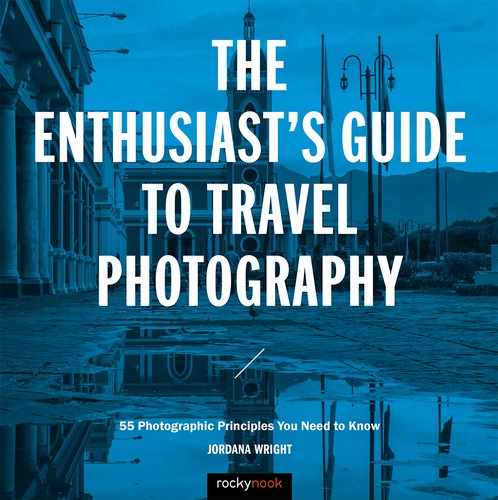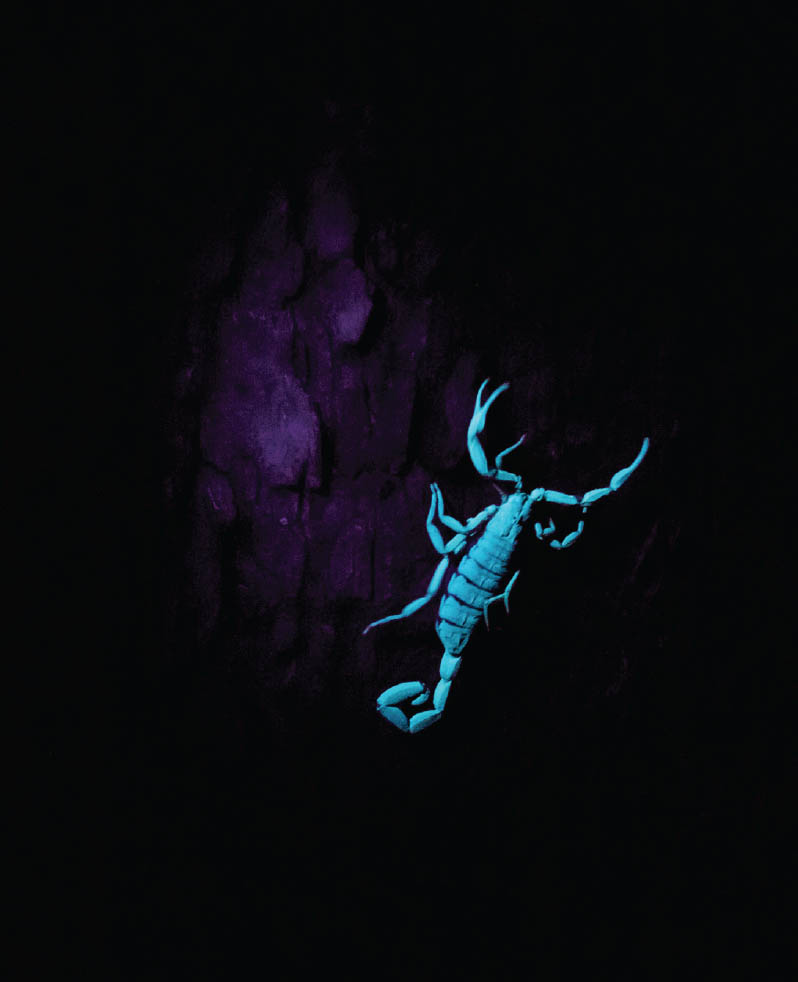43. PATIENCE IS A VIRTUE
![]()
THE FIRST TIME I went to Costa Rica I had somewhat unreasonable expectations about wildlife viewing. I grew up watching nature documentaries, so I was excited to personally see the abundant creatures of the jungle. But I had no idea just how long most documentarians lie in wait to get footage of their subjects. My early self-guided attempts at exotic animal spotting were fruitless, though I did find two entangled amorous lizards and a couple of crabs.
I quickly learned that much of wildlife photography requires an endless supply of patience—not unlike my early days as a preschool photographer. Just showing up at the recommended locations isn’t enough. You have to be willing to put in the time, do the research about your intended subjects’ interests and behaviors, and play an often frustrating waiting game. For those of us who don’t have endless supplies of vacation days and cash, patience is still important, but there are a few things we can do to improve our chances of finding exciting subjects and photo opportunities.
Enlist the Experts
While the miracle of life that is lizard love was an exciting personal find (Figure 43.1), I have had the most luck working with a local guide to find wildlife to photograph. On that first trip to Costa Rica, a half-day hike in the jungle with a barefoot one-eyed Tico yielded sightings of multiple sloths (two- and three-toed, though I didn’t get close enough to count toes), howler and capuchin monkeys, arboreal snakes, sleeping bats, and a hawksbill turtle. The turtle on land in daylight was a fluke—she had gotten stuck in some fallen palm trees after laying her eggs on the beach, but because we had a local expert on hand to spot her in the first place, we were able to help free her and lead her back into the ocean. No, I didn’t get pictures. Yes, it was amazing anyway.
43.1 Wildlife on the ground is much easier to spot if you’re an amateur. Puerto Viejo, Costa Rica
ISO 100; 1/160 sec.; f/7.1; 150mm
None of those sightings would have been possible without a guide who knew the behaviors, habitats, and signs of the animals nearby. Now I rarely venture into the jungle without a guide for spotting (Figures 43.2 through 43.4).
43.2 Howler monkeys are easier to hear than they are to spot. Charco Verde, Ometepe, Nicaragua
ISO 1250; 1/160 sec.; f/6.3; 300mm
43.3 This little dude was seriously camouflaged. Mombacho Volcano, Nicaragua
ISO 400; 1/160 sec.; f/6.3; 300mm
43.4 Without a guide, I never would have known where to find a scorpion in the jungle, nor would I have known to look at him glow under a UV light. Monteverde, Costa Rica
ISO 6400; 1/125 sec.; f/5.6; 85mm
With any kind of wildlife photography—especially in situations where the animals could be potentially dangerous (e.g., the eyelash viper that I wouldn’t have spotted that was well within striking distance) or when your presence could potentially harm the animals—a knowledgeable guide is a worthy investment.
Minimize Points of Friction
Most animals are skittish and humans are noisy and smelly. If you’re in pursuit of a particularly elusive creature, you’ll have your work cut out for you even if you do hire an expert guide. Focus on stepping lightly, minimizing conversation, and turning off all potentially noisy accessories and features (Figures 43.5 and 43.6).
43.5 I wanted to make an environmental portrait of this lizard with a wide-angle lens, so I gradually inched closer to him to line up my shot. Arches National Park, Moab, Utah
ISO 125; 1/125 sec.; f/13; 10mm
43.6 Hiking quietly paid off when a family of coatis ventured close to us on the trail. Tenorio Volcano National Park, Costa Rica
ISO 3200; 1/125 sec.; f/5.6; 85mm
We were carefully searching the treetops for sloths on a jungle night tour in Costa Rica when my phone shouted from inside my backpack, “I’m sorry, I didn’t catch that. Did you say something?” Super embarrassing. After being told explicitly that any sound would hinder wildlife viewing opportunities, I had set my phone’s ringer and notifications to silent. The general app volume, however, was at full blast. I achieved full idiot status and the sloths remained fully hidden. Turn off the beeping on your camera if you haven’t already, and turn all volume settings on your phone to silent even if you’re out of network.
It’s a good idea to try to keep your scent pretty neutral. Perfumes, lotions, and fancy soaps might make you more appealing to other humans, but the animals will sense you from farther away. The only wildlife you’ll attract are mosquitoes, gnats, and flies, and they’ll make the time you spend waiting for more interesting wildlife pretty miserable. To that end, no matter how dumb you feel, if you’re going to be lying in wait in bug-prone areas, wear a netted hat and long pants and sleeves.
Take It as It Comes
Whether I’m waiting for the epic lighting of a sunset or for a family of coatis, I often struggle with self-doubt and fear of missing out. There have been many times over the years when I’ve worried or wondered if what I’m shooting is less exciting than what I might have found if I’d hiked a bit longer or driven a bit farther down the road. I have to tell myself that it doesn’t matter. Sure, there might be something totally breathtaking that I stopped short of seeing because I liked something else along the way. That’s just one of the realities of life. You can’t be everywhere at once and you can’t do everything. You have to make a choice and take it as it comes.
There are no guarantees that waiting in a tree-hide for a month will get you the shot you had hoped for, and you have no way to know if the sunrise was prettier here than it was over there (Figure 43.7). Regardless of what could be happening somewhere else, you have to find the beauty and excitement in what lies before you at that moment and work the hell out of it.
43.7 I chose my sunrise spot in the dark, so when it started to get lighter and I found that I’d chosen a topographically flat portion of The Badlands, I made the best of it. The sky wasn’t particularly exciting either, so I chose a tighter shot rather than a vista. Badlands National Park, South Dakota
ISO 100; 1/400 sec.; f/5.6; 85mm







